Another goldwork thread I ordered recently that struck my fancy is “gimp.” Yes, you’re right! Like flatworm, it has a weird name!
Gimp is a goldwork cord. I can’t bring myself to call it a thread – it’s pretty large! It fits in the goldwork category because it is metal; it’s made up of a thread core that is wound with gold wire. I’ll show you the anatomy of gimp cord in a bit, but for starters, let’s look at it and then compare it to another twisted goldwork thread.
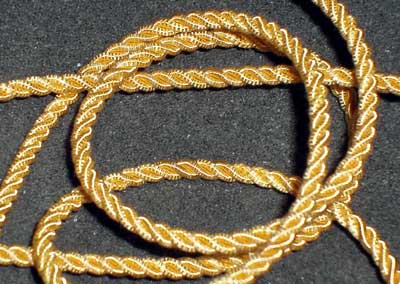
Now, if you like goldwork, when you take a look at gimp cord, you won’t be able to help liking it, too! It’s beatiful. It’s heavy and rich, a beautiful three-ply cord. Unlike other goldwork threads, there isn’t much “sparkle” to it. Gimp gleams. It almost has a matte-like look to it.
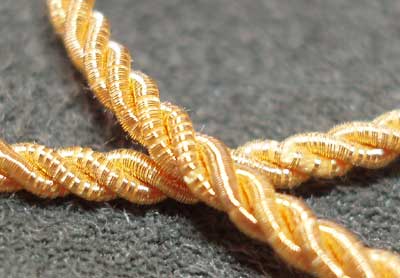
When you look at it up close, you can see that it’s made out of some kind of wrapping that seems to divide a bit. The camera really helps here – to the un-aided eye, the cord simply looks golden.
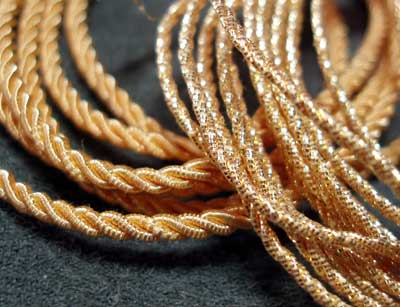
Compared to gold twist, gimp suddenly doesn’t look as “metal” looking. The gold twist – also a three-ply twisted goldwork thread – reflects the light differently, because it’s made differently.
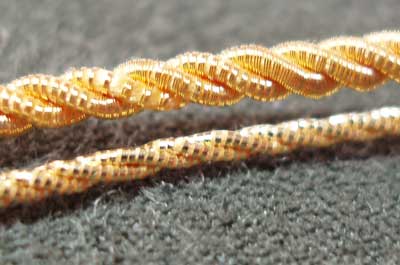
Size-wise, this is a #6 (so, relatively large) twist in the front, with the gimp behind it. Gimp is bigger, and it is more tightly twisted.
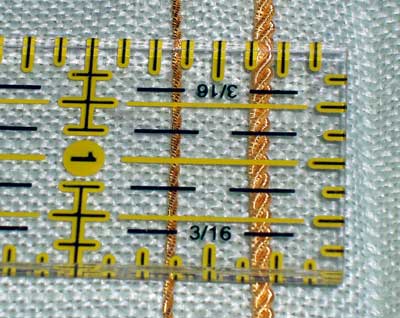
If you measure them under a ruler, you can see that gimp is practically an eighth of an inch wide, compared to the twist, which is certainly less than half that wide.
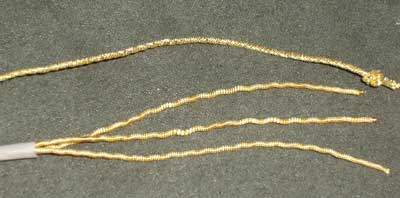
When you buy gimp, it comes with the edges taped or clamped, for a Very Good Reason. Because of the tight twist, once the ends are unbound, the whole cord very quickly starts to unwind. To solve this, bind the cord where you plan to cut it, and leave the ends bound until it’s sewn onto the fabric! Anyway, for the photo above, I unbound the end before I realized what would happen, and the gimp began to furiously untwist. I caught it before it went too far – about three inches – but still, three inches is a lot, when you’re talking about a thread that costs $18 / yard… That’s $1.50-worth of unwinding. I learned my lesson!
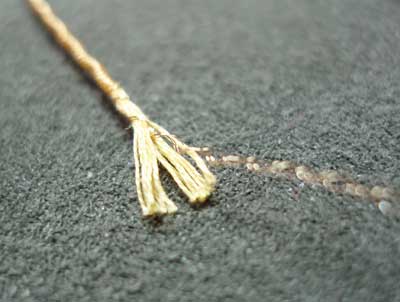
This is the fascinating thing about gimp cord. It doesn’t look as metal-like, but it is truly just as much a metal thread as smooth passing or twist. You see, twist, is made up of what looks like three strands of smooth passing twisted together. Smooth passing is made from a core (cotton or other fiber) wound with a wire that is wide and flat, kind of more like a very tiny tape of gold. Gimp cord is made with a core of threads, around which is wound teeny tiny gold wires – they’re about the size of a hair. Three of the wires are grouped together and wrapped around the core. If you pull on the wire end, the core will unwrap (just as it does with passing thread) but the gold that comes off is entirely different stuff!
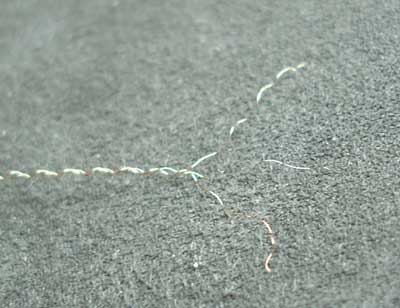
It was difficult to get a decent photo of them, but there they are. Three gold wires! WOW – those tiny wires are the rich coating that makes gimp cord so gorgeous! Amazing!
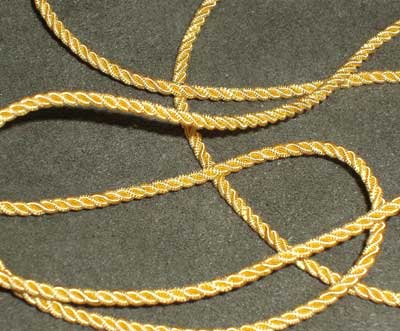
Gimp cord is a heavier, more supple thread than twist. It is really lovely stuff!
I can see it used in a lot of ways, but primarily, I could see it outlining stitched areas on ecclesiastical work or used as thick vines or stems on goldwork pieces. I’m eager to try working with it!
Have you used gimp cord before? Or have you seen it in use? Any pointers or observations about it?? Let me know by leaving a comment below!







I enjoy the information that you share with us needleworkers. Whoever receives that book and threads would really enjoy doing projects from that book.
As an heirloom sewer I have always thought of gimp cord as a cord you cover with a colorful satin stitch with your sewing machine and attach it to the edge of a decorative item such as a hem of a dress or to embellish a cuff etc. I like the fact you can get the cord covered in gold and use if for hand needlework. It would make the project become so beautiful,it stands out!
Annie
Well-Mary, I have to say I’m really not very fond of this gold metallic gimp. I do, however, love gimp when it is made from long satin strands of thread; the kind that is used for upholstery trim. The word gimp is also used to specifically name a particular trim that is glued around raw edges of an upholstered item. This gimp is known in the industry as a continuous “s” shape (called “scroll”) on a textured tape,usually all of one color. It is purchased with or without a “lip” or attached tape. No, not my favorite-not as pretty as viscose sheen in jewel tone.